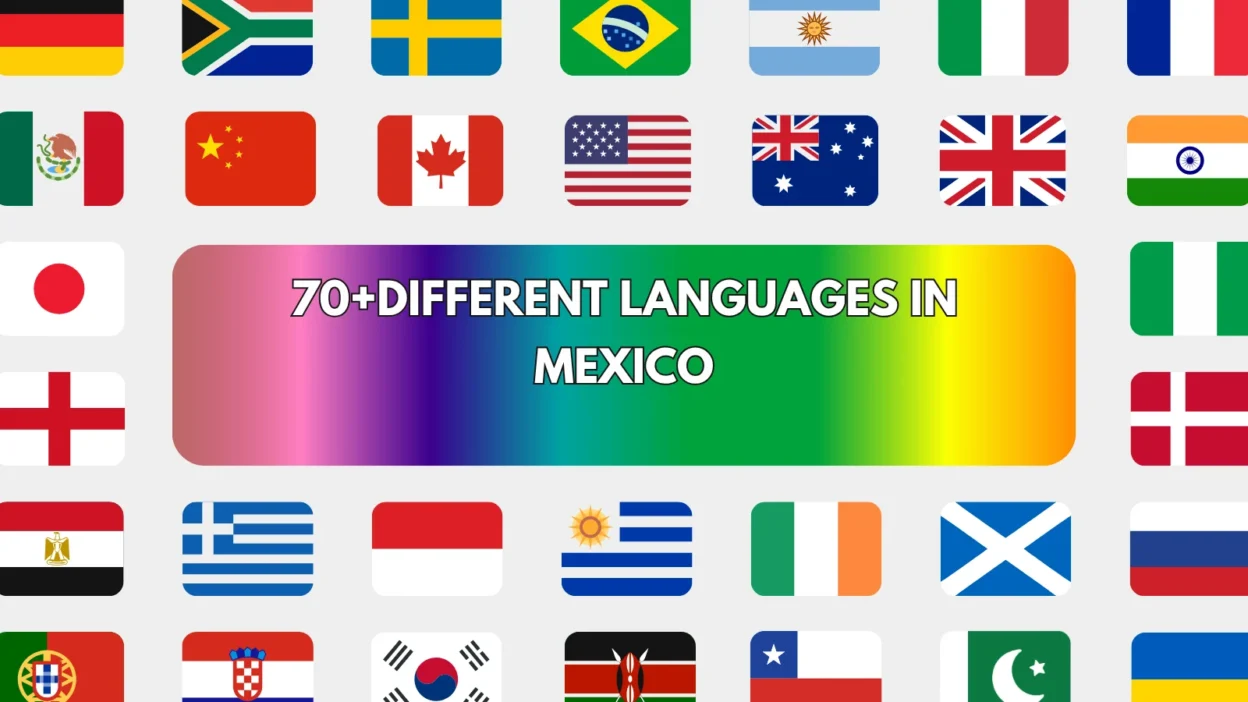Mexico is one of the most linguistically rich countries in the world, home to 68 officially recognized national languages: Spanish and 67 indigenous languages, each with multiple dialects. These tongues reflect centuries of history, identity, and cultural heritage. From the Nahuatl spoken in the Aztec capital to the Mayan languages of the Yucatán Peninsula, each carries a unique story.
This guide covers 70 languages spoken in Mexico, including the major indigenous tongues and regional variants, giving you a complete look at this living mosaic.
70 Languages Spoken in Mexico
- Spanish 🇲🇽 – Español | Pronunciation: es-pah-NYOL
Example: En México, la mayoría habla Español. - Nahuatl 🇲🇽 – Nāhuatl | Pronunciation: NAH-watl
Example: Muchas palabras mexicanas provienen del Nāhuatl. - Maya Yucateco 🇲🇽 – Maaya T’aan | Pronunciation: MAH-yah t-aan
Example: En Yucatán, muchos hablan Maaya T’aan. - Zapoteco 🇲🇽 – Diidxazá | Pronunciation: deed-sha-ZAH
Example: En Oaxaca, el Diidxazá sigue vivo. - Mixteco 🇲🇽 – Tu’un Savi | Pronunciation: toon SAH-vee
Example: Tu’un Savi es una lengua con muchos dialectos. - Tzotzil 🇲🇽 – Bats’i k’op | Pronunciation: bat-SEE kop
Example: Bats’i k’op se habla en Chiapas. - Tzeltal 🇲🇽 – Bats’il k’op | Pronunciation: bat-SEEL kop
Example: Muchos pueblos mayas hablan Bats’il k’op. - Otomí 🇲🇽 – Hñähñu | Pronunciation: nyah-NYUH
Example: Hñähñu se escucha en el centro de México. - Mazateco 🇲🇽 – Ha shuta enima | Pronunciation: ha SHU-ta eh-NEE-ma
Example: Mazateco es rico en tradiciones orales. - Chinanteco 🇲🇽 – Tsa ju jmí | Pronunciation: tsa hoo HMEE
Example: Tsa ju jmí tiene varias variantes lingüísticas. - Mixé 🇲🇽 – Ayuujk | Pronunciation: ah-YUHK
Example: Ayuujk es hablado en la Sierra Norte de Oaxaca. - Huasteco 🇲🇽 – Téenek | Pronunciation: TEE-neck
Example: Téenek es parte de la familia maya. - Tarahumara 🇲🇽 – Rarámuri | Pronunciation: rah-RAH-moo-ree
Example: Los Rarámuri son famosos por su resistencia física. - Yaqui 🇲🇽 – Jiak noki | Pronunciation: hee-AHK no-kee
Example: Jiak noki se habla en Sonora. - Mayo 🇲🇽 – Yoreme | Pronunciation: yo-REH-meh
Example: Yoreme es hablado en Sinaloa y Sonora. - Tojolabal 🇲🇽 – Tojol-ab’al | Pronunciation: toh-hol-ah-BAHL
Example: Tojol-ab’al es una lengua maya. - Lacandón 🇲🇽 – Hach t’an | Pronunciation: hatch t-AN
Example: Hach t’an lo hablan pocos en Chiapas. - Chol 🇲🇽 – Lakty’añ | Pronunciation: lakh-tee-AN
Example: Lakty’añ sigue vivo en Tabasco y Chiapas. - Purépecha 🇲🇽 – P’urhépecha | Pronunciation: poo-REH-peh-cha
Example: P’urhépecha se habla en Michoacán. - Cora 🇲🇽 – Náayeri | Pronunciation: NAH-yeh-ree
Example: Náayeri es hablado en Nayarit. - Huichol 🇲🇽 – Wixárika | Pronunciation: wee-HAH-ree-ka
Example: Wixárika se escucha en la Sierra Madre Occidental. - Triqui 🇲🇽 – Tnu’u | Pronunciation: t-noo
Example: Tnu’u es una lengua tonal de Oaxaca. - Chontal de Oaxaca 🇲🇽 – Lowoko | Pronunciation: lo-WO-ko
Example: Lowoko es una lengua chontal viva. - Amuzgo 🇲🇽 – Ñomndaa | Pronunciation: nyom-DAH
Example: Ñomndaa se habla en Guerrero y Oaxaca. - Popoluca 🇲🇽 – Nuntajɨɨyi | Pronunciation: noon-tah-HEE-yee
Example: Nuntajɨɨyi tiene raíces muy antiguas. - Mazahua 🇲🇽 – Jñatrjo | Pronunciation: nyah-TRO-ho
Example: Jñatrjo es hablado en el Estado de México. - Kikapú 🇲🇽 – Kikapoo | Pronunciation: kee-kah-POO
Example: Kikapoo proviene del norte de México. - Guarijío 🇲🇽 – Macurawe | Pronunciation: mah-coo-RAH-weh
Example: Macurawe se habla en Chihuahua y Sonora. - Pame 🇲🇽 – Xi’iuy | Pronunciation: shee-EE-wee
Example: Xi’iuy pertenece a la región Huasteca. - Chichimeca Jonaz 🇲🇽 – Uza | Pronunciation: oo-ZAH
Example: Uza es hablado por pocos hablantes en Guanajuato. - Cuicateco 🇲🇽 – Tsa ju jmi | Pronunciation: tsa-hoo-HMEE
Example: Cuicateco es originario de Oaxaca. - Ixcateco 🇲🇽 – Xwja | Pronunciation: shoo-ha
Example: Xwja está en peligro de extinción. - Chatino 🇲🇽 – Cha’tnï | Pronunciation: CHA-tnee
Example: Cha’tnï es hablado en Oaxaca. - Tepehua 🇲🇽 – Tepehua | Pronunciation: teh-PEH-wah
Example: Tepehua tiene tres variantes principales. - Zoque 🇲🇽 – O’ de püt | Pronunciation: oh-deh-POOT
Example: O’ de püt se habla en Chiapas y Oaxaca. - Sayulteco 🇲🇽 – Sayula Popoluca | Pronunciation: sah-YOO-lah poh-poh-LOO-kah
Example: Sayula Popoluca es de Veracruz. - Kumiai 🇲🇽 – Kumiai | Pronunciation: koo-MEE-eye
Example: Kumiai se habla en Baja California. - Paipai 🇲🇽 – Paipai | Pronunciation: pie-PIE
Example: Paipai es hablado por pocos en Ensenada. - Kiliwa 🇲🇽 – Kiliwa | Pronunciation: kee-LEE-wah
Example: Kiliwa está casi extinta. - Cochimí 🇲🇽 – Cochimí | Pronunciation: koh-chee-MEE
Example: Cochimí se hablaba en Baja California. - Guaycura 🇲🇽 – Guaycura | Pronunciation: why-COO-rah
Example: Guaycura está extinta. - Ayapaneco 🇲🇽 – Nuumte Oote | Pronunciation: noom-teh OH-teh
Example: Solo unos pocos hablan Nuumte Oote. - Chontal de Tabasco 🇲🇽 – Yokot’an | Pronunciation: yo-ko-TAHN
Example: Yokot’an vive en comunidades ribereñas. - Tlapaneco 🇲🇽 – Me’phaa | Pronunciation: meh-PAH
Example: Me’phaa es hablado en Guerrero. - Mixe Zoque Popoluca 🇲🇽 – Ayapaneco mixe-zoqueano | Pronunciation: mee-heh-soh-KEH-ah-no
Example: Se encuentra en el sureste mexicano. - Huave 🇲🇽 – Ombeayiüts | Pronunciation: om-BEYE-yuts
Example: Ombeayiüts es de Oaxaca. - Tacuate 🇲🇽 – Tacuate | Pronunciation: tah-KWAH-teh
Example: Tacuate es un mixteco particular. - Tlahuica 🇲🇽 – Pjiekak’joo | Pronunciation: pee-yeh-KAH-k-hoo
Example: Pjiekak’joo se habla en Morelos. - Ocuilteco 🇲🇽 – Tlacualero | Pronunciation: tla-kwah-LEH-ro
Example: Tlacualero es hablado por pocos ancianos. - Totonaco 🇲🇽 – Tutunakú | Pronunciation: too-too-NAH-koo
Example: Tutunakú es conocido por su música tradicional. - Q’anjob’al 🇲🇽 – Q’anjob’al | Pronunciation: k-an-ho-BAHL
Example: Q’anjob’al se habla en comunidades migrantes. - Mam 🇲🇽 – Mam | Pronunciation: mahm
Example: Mam es parte de la familia maya. - Kanjobal 🇲🇽 – Kanjobal | Pronunciation: kan-ho-BAHL
Example: Kanjobal se habla en la frontera sur. - Aguacateco 🇲🇽 – Awakateko | Pronunciation: ah-wah-kah-TEH-ko
Example: Awakateko es raro en México. - Ixil 🇲🇽 – Ixil | Pronunciation: ee-SHEEL
Example: Ixil es de origen guatemalteco. - Jacalteco 🇲🇽 – Popti’ | Pronunciation: pop-TEE
Example: Popti’ es hablado en Chiapas. - Chuj 🇲🇽 – Chuj | Pronunciation: choo-H
Example: Chuj es lengua maya minoritaria. - Poqomchi’ 🇲🇽 – Poqomchi’ | Pronunciation: poh-kohm-CHEE
Example: Poqomchi’ tiene muy pocos hablantes. - Achi 🇲🇽 – Achi | Pronunciation: ah-CHEE
Example: Achi se encuentra en comunidades migrantes. - Garífuna 🇲🇽 – Garífuna | Pronunciation: gah-REE-foo-nah
Example: Garífuna es afroindígena de la costa caribeña. - Creole Inglés 🇲🇽 – English Creole | Pronunciation: ING-lish KREE-ohl
Example: English Creole se habla en islas del Caribe mexicano. - Seri 🇲🇽 – Cmiique iitom | Pronunciation: cm-EE-keh ee-TOM
Example: Cmiique iitom es de Sonora. - Opata 🇲🇽 – Opata | Pronunciation: oh-PAH-tah
Example: Opata está extinta pero documentada. - Pochuteco 🇲🇽 – Pochuteco | Pronunciation: poh-choo-TEH-ko
Example: Pochuteco desapareció hace siglos. - Cahuilla 🇲🇽 – Cahuilla | Pronunciation: kah-WEE-yah
Example: Cahuilla tiene raíces compartidas con el suroeste de EE.UU. - Mocho’ 🇲🇽 – Mocho’ | Pronunciation: moh-CHO
Example: Mocho’ es maya y en peligro crítico. - Teko 🇲🇽 – Teko | Pronunciation: TEH-ko
Example: Teko se habla en Chiapas. - Awakateko 🇲🇽 – Awakateko | Pronunciation: ah-wah-kah-TEH-ko
Example: Awakateko es minoritario en el sur. - Sanuma 🇲🇽 – Sanuma | Pronunciation: sah-NOO-ma
Example: Sanuma es extremadamente raro. - Kaqchikel 🇲🇽 – Kaqchikel | Pronunciation: kahk-CHEE-kel
Example: Kaqchikel se escucha en comunidades migrantes mayas.
Conclusion
Mexico’s linguistic landscape is like a living museum of cultures. Each of the 70 languages listed here carries its own history, worldview, and unique beauty. While Spanish unites the country, indigenous languages keep alive traditions passed down over centuries. Sadly, many of these tongues face extinction due to globalization and urban migration.
Yet, communities and linguists work tirelessly to preserve them for future generations. By recognizing and respecting this diversity, we help maintain the heart of Mexico’s identity — its voice. Every language here is a song of heritage, a bridge to ancestors, and a living thread in the fabric of the nation.




